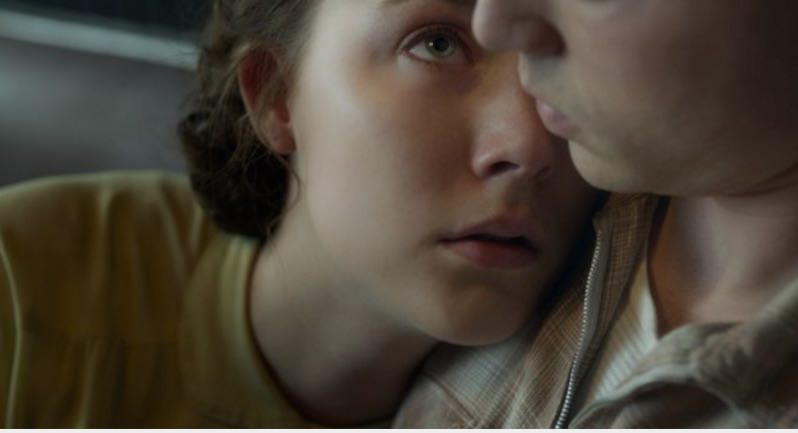‘Brooklyn’ Film Review: An Ugly Duckling Soars From New Ground
Director John Crowley strikes universal chords in this adaptation of a much-praised novel, and Saoirse Ronan paints a remarkable image of transformation as a young Irish woman who finds herself after crossing the Atlantic. Saoirse Ronan and Emory Cohen in "Brooklyn." (IMDb)
Saoirse Ronan and Emory Cohen in "Brooklyn." (IMDb)
Some films you look at. Others are so immediate that you live and breathe and dance with the characters. John Crowley’s incomparable “Brooklyn” is a movie of the second kind, and what a privilege it is to live there, however briefly.
Based on the much-praised 2009 novel by Colm Tóibín and set in 1950s County Wexford, Ireland, and the eponymous borough of New York, “Brooklyn” is about both coming to America and coming of age.
In the town of Enniscorthy, Eilis (Saoirse Ronan) has a pinched look. Could be the economy, for the 18-year-old is able only to get part-time work at a bakery on Sundays after Mass. Could be the lack of social opportunity, for the chances to mix with others her age are even fewer than the available jobs. The way her body folds into itself suggests that Eilis (say AY-lish) doesn’t want to take up any space or anyone to take notice of her.
She lives in the shadow of Rose, her elder sister, and Nancy, her best friend, charismatic brunettes with color and oomph. When the reluctant Eilis accompanies Nancy to a Saturday night dance, no one would call this retiring girl a wallflower. Wall weed is more like it: Eilis is nondescript, spindly — an undesirable intruder in the garden of Irish roses.
Through the parish church her sister arranges that Eilis sail to Brooklyn, where a job, a room in a boardinghouse and the good offices of Father Flood (the jolly Jim Broadbent) await her.
As you’ve no doubt already guessed, the weed takes root in the Brooklyn soil and blooms into a rare flower. One of the small miracles of Crowley’s film is the subtlety with which Eilis unfolds her body, and moves into the sun, all the better to see her ethereal blue eyes take in her surroundings.
Francois Truffaut liked to say that the most local story is the most universal, and “Brooklyn” is a proof. It strikes so many universal chords. It’s an immigrant tale of the stranger in the strange land, a transformation story of the ugly-duckling kind and, most significantly, an account of how to stop others from defining one and proudly defining oneself.
Not only is the screenplay (adapted by Nick Hornby from Tóibín’s novel) surprising lyrical, the film is ravishing to look at. As Eilis becomes increasingly at home in Brooklyn, the color palette of Canadian cinematographer Yves Belanger changes from oatmeal to mint-chip sundae, cool greens and warm chocolate browns, like an MGM musical of the period.
Yet it is the performances that carry the film’s themes of sorrow and joy, heartsickness and health. And Ronan carries the film on those narrow, sloping shoulders. Eilis begins as an inarticulate girl of few words and no expectations. Incrementally — that’s an important word, because it is those tiny changes in her that give the viewer a rooting interest — she becomes an eloquent young woman startled that she can make her own choices. This is not a transformation achieved by makeup and wardrobe. It comes from relaxing pinched muscles and switching on an inner light. Ronan makes Eilis’ change achingly real.
She is supported by a number of equally fine actors, notably Emory Cohen as Tony, an Italian-American who has a thing for Irish girls, and Julie Walters as Mrs. Kehoe, the Irish-American proprietress of a Brooklyn boardinghouse where Eilis finds friends, frenemies and support. Domhnall Gleeson is quietly powerful as Jim, the Enniscorthy swain who never notices Eilis until she returns to Ireland for a family emergency.
Credit Crowley, previously the director of the emotionally wrenching “Boy A,” and Hornby, novelist of “About a Boy,” for this poignant adaptation of a story. Their collaboration has the effect of delayed-action bliss.
Your support matters…Independent journalism is under threat and overshadowed by heavily funded mainstream media.
You can help level the playing field. Become a member.
Your tax-deductible contribution keeps us digging beneath the headlines to give you thought-provoking, investigative reporting and analysis that unearths what's really happening- without compromise.
Give today to support our courageous, independent journalists.




You need to be a supporter to comment.
There are currently no responses to this article.
Be the first to respond.